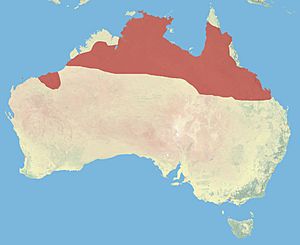Spectacled hare-wallaby facts for kids
Quick facts for kids Spectacled hare-wallabyTemporal range: Recent
|
|
|---|---|
 |
|
| Plate 58 of Mammals of Australia Vol. II | |
| Conservation status | |
| Scientific classification | |
| Genus: |
Lagorchestes
|
| Species: |
conspicillatus
|
| Subspecies | |
|
|
 |
|
| Spectacled hare-wallaby range | |
The spectacled hare-wallaby (Lagorchestes conspicillatus) is a type of macropod. Macropods are a group of marsupials that include kangaroos and wallabies. This special animal lives in parts of Australia and New Guinea.
In Australia, a small group of these wallabies lives on Barrow Island. The main group lives across the northern parts of the country. However, their numbers are slowly decreasing.
Contents
Meet the Spectacled Hare-Wallaby!
The spectacled hare-wallaby is a small member of the macropod family. It is known for its unique look.
What Does It Look Like?
This wallaby is grey-brown with golden tips on its fur. It has a bright orange circle around each eye, which is how it got its name, "spectacled." It is bigger than its close relatives, the other hare-wallabies.
Where Does It Live?
You can find the spectacled hare-wallaby across northern Australia. It prefers tropical areas with tall, tough grasses like tussock or spinifex. Its home stretches from Queensland to Western Australia. In 1997, it was also found in the savanna areas of southwest Papua New Guinea.
Daily Life and Habits
This wallaby is a shy animal that lives alone. It is also nocturnal, meaning it is active at night. During the day, it rests in nests it builds among the tough plants. It eats only plants, making it a herbivore. If something scares it, the wallaby hops away in a quick zigzag pattern to escape.
Reproduction and Life Cycle
Female spectacled hare-wallabies usually have one baby at a time. They can have babies at any time of the year. The young wallabies grow up quickly and can have their own babies when they are about one year old.
Naming and History
The spectacled hare-wallaby was first officially described by a scientist named John Gould in 1842. He gave it the scientific name Lagorchestes conspicillata. He also included a drawing of it in his famous book, The Mammals of Australia.
Another hare-wallaby, called Lagorchestes leichardti, was also described in the same book. Today, scientists believe this is just a different group of the same spectacled hare-wallaby species. Sometimes, it's called a subspecies.
Protecting the Spectacled Hare-Wallaby
The spectacled hare-wallaby is currently listed as "least concern" on the IUCN Red List. This list helps track how endangered different species are. However, its population is decreasing.
Why Are Their Numbers Declining?
One of the biggest reasons for the decline is the loss of their habitat. This happens when land is cleared for other uses. There is also concern because they are disappearing from some of the drier parts of their northern range.
Protecting Subspecies
There are two main groups, or subspecies, of the spectacled hare-wallaby:
- The L. conspicillatus conspicillatus subspecies lives only on Barrow Island in Western Australia. It used to live on the Montebello Islands too. This group is considered "vulnerable" because of new animals brought to the island and new buildings being built.
- The L. conspicillatus leichardti subspecies lives on the mainland of Australia. This group was once thought to be "near-threatened."
Scientists are looking into ways to help these wallabies. They have even suggested bringing them back to areas where they used to live, similar to other successful projects like the Western Shield program.
Images for kids



